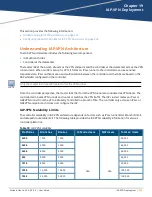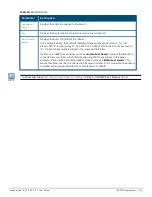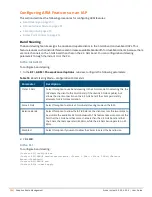
Distributed, L2 Mode
In this mode, the IAP assigns an IP address from the configured subnet and forwards traffic to both corporate
and non-corporate destinations. Clients receive the corporate IP with VC as the DHCP server. The default
gateway for the client still resides in the datacenter and hence this mode is an L2 extension of corporate VLAN
to remote site. Either the controller or an upstream router can be the gateway for the clients. Client traffic
destined to datacenter resources is forwarded by the master IAP (through the IPsec tunnel) to the client's
default gateway in the datacenter.
When an IAP registers with the controller, the controller automatically adds the VPN tunnel associated to this
IAP into the VLAN multicast table. This allows the clients connecting to the L2 mode VLAN to be part of the
same L2 broadcast domain on the controller.
Distributed, L3 Mode
The Distributed, L3 mode contains all broadcast and multicast traffic to a branch. The Distributed, L3 mode
reduces the cost and eliminates the complexity associated with the classic site-to-site VPN. However, this mode
is very similar to a classic site-to-site IPsec VPN where two VPN endpoints connect individual networks together
over a public network.
In Distributed, L3 mode, each branch location is assigned a dedicated subnet. The master IAP in the branch
manages the dedicated subnet and acts as the DHCP server and gateway for clients. Client traffic destined to
datacenter resources is routed to the controller through the IPsec tunnel, which then routes the traffic to the
appropriate corporate destinations.
When an IAP registers with the controller, the controller adds a route to enable the routing of traffic from the
corporate network to clients on this subnet in the branch.
Centralized, L2 Mode
The Centralized, L2 mode extends the corporate VLAN or broadcast domain to remote branches. The DHCP
server and the gateway for the clients reside in the datacenter. Either the controller or an upstream router can
be the gateway for the clients. For DHCP services in Centralized, L2 mode, Aruba recommends using an
external DHCP server and not the DHCP server on the controller. Client traffic destined to datacenter
resources is forwarded by the master IAP (through the IPsec tunnel) to the client's default gateway in the
datacenter.
Centralized, L3 Mode
For Centralized, L3 clients, the VC acts as a DHCP relay agent that forwards the DHCP traffic to the DHCP server
located behind the controller in the corporate network and reachable through the IPsec tunnel. The
Centralized, L3 VLAN IP is used as the source IP. The IP address is obtained from the DHCP server.
Aruba Instant 6.5.0.0-4.3.0.0 | User Guide
IAP-VPN Deployment |
244
















































